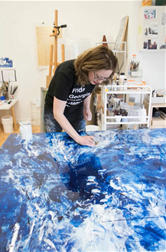Jelly Green is a great example of how to keep the same voice through different platforms, for example Instagram and her website. Websites are often presented in a more professional way, where as Instagram and other social media platforms don’t have that connotation. This is because there is a closer connection with Instagram and the audience, it feels more personal as people go to your social media to see what you are up to on a regular basis where as websites are often used to see the final product, look at previous work as well as to find other information, for example how to buy artwork.
When you look at Jelly Green’s artwork on Instagram there is a three image layout this is also found on her website when you look through ‘Recent Work’ and ‘Past Work’. Imagery is clearly very important to Green as she has a large photo on her home page and there is another large photo on her about page, these photos feel like her artwork and her posts on Instagram as these large photos on her website show her working in the jungle, the environment that she recreates in her paintings. Green likes to share progress photos, sketches, time lapses, her studio space as well as images of finished paintings, these photos of her drawing in the jungle have a similar feel, but look more professional, as we see her working, or in the case of the photo on the home page we have a her hand, a pencil, an open sketchbook and a closed sketchbook on the ground.
The website is easy to use, simple and effective, there is a menu in the top right corner which can take you to ‘About’ where she has her biography and past exhibitions information, she also has a ‘Press’ section, where she promotes articles written about her, Green shares this information on her Instagram as well. Green uses similar language throughout her Instagram posts and website keeping it all simple, easy to follow and professional.
In the ‘Recent Work’ page she has images of work from 2016 – 2020 and ‘Past Work’ which shows work from 2013 – 2017. This is a little confusing as the years overlap, asking the question what constitutes an artwork being in the ‘Past Work’ page vs the ‘Recent Work’ page if there is artwork from 2016 – 20117 in both. Is this website not updated as frequently? The artwork is also not in chronological order, which is what I was expecting, which makes me wonder what is the order? Is there an order?
Overall, both the Instagram account and website are easy to understand use and there is a common feel though both, there is a lot of green in her paintings and this is found in her website design as well as Green’s Instagram profile picture (a close up image of one of her paintings). This is a useful tactic and something I will consider using for myself.










